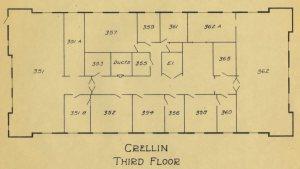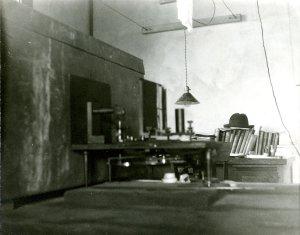
Architectural schematic for the third floor of the Crellin Laboratory.
[Celebrating the 75th anniversary of the dedication of the Crellin Laboratory at the California Institute of Technology. Part 1 of 3]
By the early 1920s, the California Institute of Technology had become, in the minds of some, “the hub of America’s scientific establishments.” This point of prestige was especially notable because Caltech was so new and very geographically distant from other major scientific research enterprises, which were predominantly located on the east coast or around the Great Lakes region. Part of this success was due to the construction of the Gates Chemistry Laboratories, built in 1917 and expanded in 1927.
The prestige and skill exhibited by Caltech caught the attention of the very influential and wealthy Rockefeller Foundation, which began supporting certain of the Institute’s operations in the early 1930s. This support was crucial for many reasons, one of them being that, by 1930, the Gates Laboratory had reached capacity. A.A. Noyes, chair of the Chemistry department at the time, commented that there was “literally no space for another research man,” and that greatly expanded facilities were exactly what the department needed to fulfill its vast potential. Linus Pauling, working in the Gates Lab, opined that the Institute was home to “the most forward looking Department of Chemistry with respect to physical chemistry in the world.” This was in no small part due to the superior leadership of Noyes, who had dramatically expanded the Chemistry and Chemical Engineering departments during his legendary tenure.

X-ray apparatus assembled on Linus Pauling’s desk in the basement of the Gates Laboratory, 1925. Pauling’s hat is seen in the rear of the photo.
The Rockefeller Foundation apparently agreed with Pauling’s assessment of Caltech’s capabilities, and in the early 1930s began to grant substantial funds to the Institute to further its leading positions in the fields of biology and chemistry. Specifically, the Institute held a key position in the development of a new field being pushed by the Foundation – a field described in 1938 as “molecular biology” by Rockefeller staffer Warren Weaver. Considering that the Great Depression was still in full swing, these additional funds were a godsend as research money was understandably difficult to come by.
In 1936, after some debate and controversy, Pauling was appointed the Chairman and Director of Caltech’s Division of Chemistry and Chemical Engineering, and also the Director of the Gates Laboratory of Chemistry, a position he held until 1958. Pauling was pleased with his increased responsibility and control, and decided that he wanted to revamp the department, and the labs in general, to better suit his vision for Caltech.
The Rockefeller Foundation agreed to provide Caltech with more money for purposes of expanding the Chemistry department and the Gates Lab. To this end, the Foundation also courted Edward W. Crellin, a retired steel magnate who lived in Pasadena. Fairly quickly, still in 1936, Crellin agreed to donate $350,000 – about $5.7 million in today’s dollars – in support of the construction of an expansion to the Gates lab, which was to be renamed the Gates and Crellin Chemical Laboratories. A year later, Crellin donated an additional $5,000 to provide floor coverings for the lab.

Edward W. Crellin.
Pauling was so pleased by Crellin’s contributions that he named his son, born June 4, 1937, Edward Crellin Pauling. Even though Edward Crellin and Crellin Pauling never got to know each other – Edward Crellin died when Crellin Pauling was only 11 – he was still flattered by Linus Pauling’s gesture, and left $5,000 in his will for Crellin Pauling.
The architects for the building initiative were Francis Mayers, Oscar Murray, and Hardie Phillip, and the project was expensive. In March 1937, Pauling received a memo from the Chemistry department that suggested cuts to the building, in order to reduce costs. The memo listed 29 suggested reductions that would lower the total cost by $47,039. The list also included three suggested additions, which would add $965 to the bill. His eyes firmly set on a world-class facility, Pauling agreed to consider only a few minor possibilities: “omit some ceiling inserts” ($240), “simplify water proofing on vertical walls” ($450), “omit birch strips on exterior walls” ($158), and “use skim coat plaster” ($200).
In addition to the building itself, outfitting costs for the new space were also high. The equipment required for the lab to function ran to $36,000 – $51,000, depending on the contractor. In addition, basic chemicals were an extra $1,200. The Chemistry department rejected Pauling’s request for more specialized analytical machines, as they would tack on an extra $4,500.
The process of bartering for and ultimately purchasing the materials that the new lab would need was slowed down in July 1937 by over three weeks, when Carl Niemann, a colleague that Pauling had entrusted to do much of the purchasing, was hospitalized. Niemann wrote in a letter to Pauling that he had gone to see a doctor because he had a chunk of rust embedded in the cornea of his left eye, “and the first attempt to remove it was not particularly successful.” He was then hospitalized and had to “have the disturbing element removed and the seat of the injury cauterized.” Despite the potential severity of the injury, Niemann made a full recovery, and the quest to secure the necessary chemicals resumed.
Once the needed equipment and chemicals had been secured, more attention was paid to the new laboratory’s décor, and Caltech had a bronze tablet cast. The tablet, which was eventually installed at the entrance of the lab, read simply: “Crellin Laboratory of Chemistry. The Gift of Edward W. and Amy H. Crellin. 1937.”
